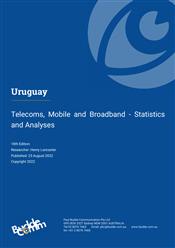Uruguay Telecoms Market Report
Telecoms, Mobile and Broadband - Statistics and Analyses

Regulator allows competition to Antel in the fixed broadband sector
Uruguay has an advanced telecom market, with excellent infrastructure and one of the highest broadband penetration rates in Latin America. Fixed-line teledensity is also particularly high for the region, while mobile penetration is the second highest after Panama. In terms of computer penetration, Uruguay tops all other countries in the region by a considerable margin, and this has facilitated growth in fixed-line broadband adoption.
The government and telecom regulator have introduced a range of measures to help develop the deployment of fibre infrastructure, partly in a bid to encourage economic growth and stimulate e-commerce. Fibre accounted for about 77% of all fixed and fixed-wireless broadband connections as of June 2020. With investment projected to reach $800 million, the state-owned incumbent Antel is expected to provide national FttP coverage by early 2022. Together with the FttP network, the opening of the submarine cable system (Bicentenario) in early 2012 and the Tannat cable in August 2017 have helped boost Uruguay’s internet bandwidth, and increase the data rate available to end-users.
Uruguay is one of the very few Latin American countries where the local fixed-line market is neither privatised nor liberalised. Antel has a monopoly in the provision of local telephony and fixed broadband services. Other segments of the telecom market have been opened to competition, including international long-distance telephony, mobile telephony, and fixed-wireless broadband.
Uruguay is also one of the few countries in the world where broadband access via cable modem does not exist. Although cable networks are well equipped technologically, and digital cable TV is widely available, telecom legislation prohibits data transmission over pay TV networks. However, the government announced in December 2020 that it intended to introduce changes to the law to permit pay TV providers to offer internet and telephony packages over their own networks.
The mobile market is dominated by Antel, with Telefónica’s Movistar in second place and América Móvil’s Claro third. All three operators offer mobile broadband through 3G and LTE networks. Operators have achieved nationwide 3G coverage and the number of mobile broadband subscribers continues to grow. Antel has been at the forefront with LTE services, though the auction of multi-band spectrum in August 2017 has also enabled Movistar and Claro to widen the reach of their LTE offers.
In April 2019 Antel launched a commercial 5G network, though limited in reach. At the end of 2019, spectrum in the 5G-suitable range was auctioned, enabling operators to launch 5G services. The regulator is working on a spectrum and connectivity policy that emphasises 5G.
Key developments:
- Legal challenge to restrictions on fixed broadband provision breaks the monopoly held by Antel;
- MNOs contract with the new MNP administrator;
- Google signs contract to build the Firmina subsea cable connecting the US with Argentina, Brazil, and Uruguay;
- América Móvil spins off towers and other related passive infrastructure in its Latin American markets;
- Antel plans to invest $152 million in fixed and mobile operations;
- Legislative changes may permit pay TV operators to offer broadband using private networks;
- Uruguay enacts Law 19,889/2020 stipulating that MNP is a right for mobile telephony customers, plans to appoint an administrator;
- Over 11,844km of fibre cable installed throughout the country, with FttP accounting for over 77% of all fixed-line broadband connections;
- Tannat cable extended to Argentina;
- Report includes the regulator's market data to December 2020, telcos' operating and financial data to Q4 2021, updated Telecom Maturity Index charts and analyses, recent market developments.
Companies mentioned in this report:
América Móvil, Antel, Claro Uruguay, Dedicado, Eutelsat, Google, Loral Spacecom Corporation, Hispasat, Millicom International Cellular (MIC), Movistar Uruguay, New Skies Satellites, Panamsat Corporation, SES Americom, Telesat Canada, Telxius.
Related Reports
- Latin America - Fixed Broadband Market - Statistics and Analyses
- Latin America - Mobile Network Operators and MVNOs
- Caribbean - Telecoms, Mobile and Broadband - Statistics and Analyses
- Peru - Telecoms, Mobile and Broadband - Statistics and Analyses
- Ecuador - Telecoms, Mobile and Broadband - Statistics and Analyses
- Guatemala - Telecoms, Mobile and Broadband - Statistics and Analyses
- Haiti - Telecoms, Mobile and Broadband - Statistics and Analyses
- Argentina - Telecoms, Mobile and Broadband - Statistics and Analyses
- Costa Rica - Telecoms, Mobile and Broadband - Statistics and Analyses
- Brazil - Telecoms, Mobile and Broadband - Statistics and Analyses
Share this Report
TMT Intelligence
A platform to scale your intelligence tasks
Monitor critical insights with our AI-powered Market Intelligence Platform gathering and analyzing intelligence in real time. With AI trained to spot emerging trends and detect new strategic opportunities, our clients use TMT Intelligence to accelerate their growth.
If you want to know more about it, please see:
Research Methodology
BuddeComm's strategic business reports contain a combination of both primary and secondary research statistics, analyses written by our senior analysts supported by a network of experts, industry contacts and researchers from around the world as well as our own scenario forecasts.
For more details, please see:
More than 4,000 customers from 140 countries utilise BuddeComm Research
Are you interested in BuddeComm's Custom Research Service?
Hot Topics
News & Views
Have the latest telecommunications industry news delivered to your inbox by subscribing to BuddeComm's weekly newsletter.